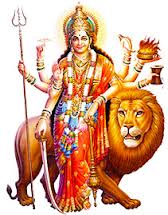Navaratri
 CHILDREN, Navaratri is over and you must have enjoyed the festival. But do you know why Navarati is celebrated and what is the meaning of the term ‘Navaratri’. The word Navaratri literally means nine nights in Sanskrit, nava meaning nine and ratri meaning nights. During these nine nights and ten days nine forms of Shakti/Devi are worshipped. There are five different Navaratri which are celebrated in five different times of the year.
CHILDREN, Navaratri is over and you must have enjoyed the festival. But do you know why Navarati is celebrated and what is the meaning of the term ‘Navaratri’. The word Navaratri literally means nine nights in Sanskrit, nava meaning nine and ratri meaning nights. During these nine nights and ten days nine forms of Shakti/Devi are worshipped. There are five different Navaratri which are celebrated in five different times of the year.
There are Vasant Navaratri: Also called Chaitra Navaratri or Ram Navaratri. Takes place during the spring season(March-April); Gupta Navaratri: Also called Ashadha, Gayatri or Shakambhari Navaratri. Takes place during the month of Ashadha (June-July); Sharad Navaratri: Most important of all the Navaratri and is celebrated in the Pratipada (the first day) of the bright fornight of the lunar month of Ashvina. Also called Sharad Navaratri (September-October); Paush Navaratri: Is observed during the Paush Shukla Paksha, i.e. January-February); Magha Navaratri is celebrated during Magha Shukla Paksha, i.e. January-February).
According to Hinduism Brahma the creator gave a boon(var) to a demon Mahisasur who then wrecked havoc on earth. Gradually he started attacking devas. Finally he decided to kill king of devas Indra. At that time on Indra and other devas plea the trinity (Lord Vishnu, Mahesh and Brahma) released a part of their energy to combine and bring down a magnificient Goddess to earth named Shakti or Durga. She had a massive fight with Mahisasur for nine days/nights during which the demon changed his forms. On the ninth day she grabbed the demon under her foot and the brutal was killed. During the nine days of Navaratri nine forms of shakti are worshipped. They are:
(a)Maa Shailputri, (b) Maa Brahmachaarin, (c) Maa Chandraghanta, (d) Maa Kush Mandaa , (e) Maa Skanda, (f) Maa Katyayni, (g) Maa Kaal Ratri, (h) Maa Har Gauri, (i) Maa Siddhidatri
During Navaratri we invoke the energy aspect of God in the form of the universal mother, commonly referred to as ‘Durga’ which literally means the remover of miseries of life. The mother Goddess is said to appear in nine forms and each one is worshipped in a day. These nine forms signify various traits that Goddess influences us with. During the eighth day or the ninth day, Kanya Poojan, pre-pubescent girls are ceremonially worshipped.
During Navaratri we worship only mother Goddess because we think we are part of the ‘Divine Mother.’ We believe that God’s glory, his cosmic energy, his greatness and supremacy can best be depicted as the motherhood aspect of God. Just as a child finds all these qualities in his or her mother, similarly, all of us look upon God as mother. Infact Hinduism is the only religion in the world, which gives so, much importance to the mother aspect of God Because we believe that mother is the creative aspect of the absolute.
Navaratri is divided into sets of three days to adore different aspects of the supreme Goddess. On the first three days, the Mother is invoked as powerful force called Durga in order to destroy all our impurities vices and defects. The next three days are, the Mother is adored as a giver of spiritual wealth, Laxshmi, who is considered to have the power of bestowing on her devotees the inexhaustible wealth. The final set of three days is spent in worshipping the Mother as the Goddess of wisdom, Saraswati. In order to have all-round success in life, we need the blessings of all the three aspects of the Divine Mother.
The Navaratri feast is observed from the first day to the ninth day. Some people confine to milk and fruits during the nine days. Most devotees take a single meal during the day. Non-vegetarian food is totally avoided.
Aniket Raja













Comments